| Tuesday, January 24, 2012 |
| Intellectual Property |
 There's no such thing. Certainly it isn't something you can steal. Quite the contrary, it is a license to steal. Specifically, it is a legal construct that gives an exclusive license to one party to stop all other parties from using certain words or certain pictures or certain designs or certain patterns of arranging things, simply because they were the first to claim that they invented those words or pictures, and that they own them. And the purported owner can then extort money from all the other people, or simply stop them from doing anything that looks like what they did. There's no such thing. Certainly it isn't something you can steal. Quite the contrary, it is a license to steal. Specifically, it is a legal construct that gives an exclusive license to one party to stop all other parties from using certain words or certain pictures or certain designs or certain patterns of arranging things, simply because they were the first to claim that they invented those words or pictures, and that they own them. And the purported owner can then extort money from all the other people, or simply stop them from doing anything that looks like what they did.
It is a tired, tired old discussion, but intellectual property is not property. It is not in any way the same as when you own a physical object of some kind, and somebody can steal it. It is not even remotely that way, and you should be insulted if anybody suggests it. If you have a car, and somebody steals that car, by removing it from you and taking it into their possession, then obviously you don't have your car any longer, a car that took quite some resources to acquire, and which took raw materials to build. As opposed to that, with our modern technologies, ideas, words and pictures are extremely easily copied, for almost no cost, while leaving the original completely intact. Your car is still there, even if somebody took a picture of it, just like your website is still there, even though somebody saved a copy of it. Your car is also still there, even if somebody went to the trouble of building a copy of it. Copying is not stealing. Not even close. If you claim so, you're running some kind of scam. The scam of Intellectual Property is quite similar to how you meet a con artist on the street. They seem friendly and they might ask you for a favor or invite you to play a little game. And before you know it, you owe them 100 dollars, and it isn't quite clear how it happened. There's a lot of apparently friendly Intellectual Property around. If you turn on the radio, there are dozens of channels playing music non-stop. They actually broadcast songs over all civilized areas, from high powered emitters. Apparently free for anybody to pick up, as long as they have the receiver, which is cheap and ubiquitous. Nowhere are you presented with any contract that says that you'll be punished for saving any of this music, or sharing it with a friend. Turn on your TV and it is the same thing. Dozens of channels broadcasting high quality content to you non-stop, for free. The same people broadcast much of this content for free on the Internet. But if you ever get the idea that you can save some of it for replaying to yourself and your friends, you're suddenly a criminal, because you didn't then drive to a store to buy a CD or a DVD with the music or film you wanted to keep. Intellectual property is like those apples one always hears about at Halloween, where some wacko embedded razorblades in them. They looked like a nice and friendly gift, but if you go off and actually try to eat them, you get hurt. Or it is like a crack dealer distributing free samples. Seems like a nice and friendly thing to do, but it is a gift you'll pay for later. There are a lot of bogus cover stories you'll be presented with. It is to support the starving artists and musicians. They need to be paid for their hard work. It is just that those people are rarely the actual people you're being asked to pay. Sony is not an artist. Neither is Warner Brothers. They are businesses trying to make a profit. If you look into the accounting that applies to the majority of artists or authors that have record deals or publishing contracts, you'll find that the vast majority of them make nothing whatsoever, or they even have to pay out of their own pocket to be published. The people who make money are the very few really big names. The Madonnas and Brad Pitts. But much more so the media companies. The rest have been scammed as much as you have. If you think it is a problem now, it can get much, much worse. Think about patents on DNA. Think about copyrights on 3D wireframe models. Think about big companies using courts to stop people from growing certain things in their gardens and from creating certain objects in their garages. In addition to stopping us from using certain words and certain melodies and certain images and likenesses. What could be a glorious future of local production and distributed creativity could instead turn into a nightmare dystopia where a few multi-national megacorps have the government backed power to turn off the things you create, or use, or grow, because they "own" them. Or have you pay them handsomely for the right to create. One possible avenue, to avoid this, is to stay far away from anything that looks like Intellectual Property, to refuse to use it, to block it, ban it. A new Internet2, free from copyrights and patents and any other kind of IP looks like a better and better idea. No, I don't mean a pirate network for sharing their stuff. I mean a network where intellectual property is banned. We just won't play their game at all. Software has been created for the purpose of identifying "owned" materials, like music or film. Imagine using it in reverse in a new Internet. I.e. anything that is "owned" will simply not be transported. Not by its owners, not by anybody. It simply won't go anywhere. Nobody wants it. In other words: If you have intellectual property, please keep it to yourself! Which is what should have happened in the first place. We call your bluff. If you made it and you think it is yours alone, fine, keep it. But don't let us catch you handing it out as a free sample to anybody that you could hope to later entrap. If you really think it is YOUR photo, keep it to yourself in a shoebox or on your computer. Don't post it to thousands of people on the Internet, and then later claim that they stole it from you. They didn't. You gave it to them. So, don't, if you don't want to. Hefty fines would be in order for anybody trying to distribute their own intellectual property in any way. Some number of dollars for each person you knowingly have distributed it to for free would be quite reasonable, if you then later make demands of money for the very same thing. So, I'm suggesting reversing the game. Blow the cover off the game when you see it. Don't allow this kind of thing on your networks. It's a crime. I'm well aware that there are very large and rich corporations that have made themselves the cultural gate keepers who somehow seem to own most of all music and film, and a lot of the words, despite them not having created any of it. And others corporations who seem to own any thinkable way of manufacturing most of the things we need. And, yes, I know that they somehow have bribed the governments of most countries to do their bidding, and their plan of turning their scheme into international law is well advanced. And they have plenty of ways of expanding their scam. Just like they can patent the vegetables in your garden and the cells in your body, they can of course also think up ways of making it seem like the music you create yourself and the videos you record violate their copyrights. They could very well have the power to position a copyright-refusing Internet2 as a haven for pirates. But if, instead of buying into their game, feeling guilty when they entrap us into pirating their stuff, you recognize it for what it is, it will be a lot harder for them. If you create spaces where their stuff isn't allowed, it will slow them down. If you call them on it, fewer people will be fooled. There's still a chance that this civilization-killing scheme can be stopped and reversed. Support people who create. Writers, musicians, photographers, artists, makers. Directly. Support their creativity. Help them make a living from it. Oppose corporations and their lawyers and politicians who make a system out of owning and stopping creativity and communication, profiting unscrupulously from the creative work of others. Create loads and loads of new stuff. In new ways, in new media. Make it altogether impractical for them to keep up. Expand the commons faster than they can privatize it. Use and support stuff that is free. Pay for and reward added value, route around ownership. [ Information | 2012-01-24 00:50 | 36 comments | PermaLink ] More > |
| Thursday, November 3, 2011 |
| Seeing the world through the Internet |
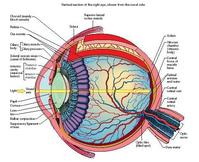 In the human eye, a system of little rods and cones pick up light that comes into the eye. Some 120 million rods in an eye will measure the intensity of the light. The 6-7 million cones will measure colors. The brain then puts all these "pixels" together into what we perceive as one coherent, continuous picture, with lots of details, in color, different shades, etc. It is a bit of an illusion, but it allows us to rather accurately predict what we find around us. You see an object, you can estimate its distance, and you can reach out your hand and find it where you expected. In the human eye, a system of little rods and cones pick up light that comes into the eye. Some 120 million rods in an eye will measure the intensity of the light. The 6-7 million cones will measure colors. The brain then puts all these "pixels" together into what we perceive as one coherent, continuous picture, with lots of details, in color, different shades, etc. It is a bit of an illusion, but it allows us to rather accurately predict what we find around us. You see an object, you can estimate its distance, and you can reach out your hand and find it where you expected.
On the Internet, we're increasingly being presented with a stream of information chunks. Compared with a few years ago, the chunks have gotten smaller and there are many more of them. Twitter, Facebook walls, Google+, SMS, e-mail, it is all streams. New stuff shows up non-stop. Thousands of items every day for most of us. At some point in the past, one would find it natural to simply process everything that showed up, because the volume of it was small. If somebody wrote me a personal letter, I would of course read it carefully, and I would of course sit down and write an answer back. Even if it took me an hour, and it was only for one person. If I subscribed to a newspaper, I would read it. And I still remember living in a country where there was one TV channel, only broadcasting in the late afternoon and in the evening. If there was anything on the program that would be within my interest area, I would watch it, as would everybody else. Today, all of that is more or less impossible, so we've gotten used to ignoring most of it, skimming a lot of it, and only digging deeply into a few choice items. So, now, as we're no longer dutifully digesting and responding to every single item, it becomes more about the overall picture of what's happening. We're noticing what people are talking about, we're noticing trends. We have a general idea about what our friends are into, based on having seen a bunch of their postings flow by in our peripheral attention. But are the information chunks we receive suitable pixels that allow us to form a coherent and continuous picture of what is there? Yes and no. We do get glimpses of a lot of incidental information that allows us to form a picture. But we also get large volumes of fictional information, stuff that's made up to present a certain picture, which isn't really what's there. We've gotten quite used to experts preparing news articles for us. Then we pass those around, adding our own like or dislike opinions about them. Other people will write new articles, quoting those first articles. Whatever they say gets amplified, distorted and colored along the way. What people trade in and respond to is those information particles. Articles, postings, words, links, likes, retweets. None of that includes much in terms of ways of interacting with the source matter, the stuff that's actually there, or that actually happened. OK, an article might have links to sources, or to organizations being discussed. It might have pictures. There might be live or recorded video, showing actual events. But the ratio of actual stuff to opinions about such stuff is relatively low. This all gives me the problem of how I can assemble a coherent and reasonably correct picture of stuff through the medium of electronic communications. First of all, all the pieces aren't easily assembled. They don't necessarily fit together. And even if I assemble what they say, the picture might be of something mostly fictional. Fox News presents a rather coherent picture, but it probably isn't what actually is there. Imagine then the difficulties of a Semantic Web, where the meaning of stuff supposedly would be brought out, simply by automatically examining how things are tagged. Spam and propaganda and misdirection are all included into the picture. How can we make the stream of info pieces more useful for assembling useful pictures of what is there? Incidental, peripheral information is often more honest than what is contrived and constructed to send a certain message. If somebody's sending you a message, you can expect that they've constructed the message to say just what they'd like you to receive, that it is somehow twisted to their advantage, and that they've left out lots of things that aren't what they wanted to say. There doesn't have to be any sinister motives for that, almost everybody's doing it to one degree or another. It is hard to know who people really are, if you only listen to their carefully crafted press releases, or tweets, or lectures, or comments. It is hard to know what really happened, if you get it from somebody with an economic interest in presenting it a certain way. Incidental, unguarded, raw information feeds might be much better in conveying the complexity of the world, and might thus be much better material for assembling an image fo what is there. If you're watching somebody give a presentation, a video feed would allow you to pick up much more information than the words he's saying, in the form of body language, the setting he's in, who else is there, etc. Whereas you only get to know certain choice aspects of a certain person's personality from reading their tweets, an open video channel would tell you a lot more. Imagine just opening up a video conference connection with a friend for an hour, while each of you went about your normal business. If you simply ignored each other, you might well learn more about each other than if you had had an intense conversation during that time. Because you would convey information that isn't prepared and prepackaged to look a certain way. The complexity of the truth would be more available. Who you're receiving phone calls from, how you talk to your kids, what you actually spend your time on, how you look when you're not trying to look good, etc. There are other ways it could happen than live video of course, but that is one good example. You'll notice that we have several kinds of Internet tools. Most of them are meant for conveying stuff that's constructed. Others are meant for conveying something more raw. There are location services that transmit your location, no matter where you are. There are others than let you check in when you're in an interesting place. Notice the difference. If I'd want to form a more true picture of you, I'd find more use in the continuous raw feeds, which also tells me that you go to the supermarket and the bank, not just when you travel to exotic places. So, please, give me more raw un-edited feeds of everything. Also and particularly for big corporations and governments. I don't just want to see ads and speeches. I want to see raw complex feeds that I can piece together into what they actually are doing, not what they say they're doing. Also, think about the raw material available for our collective intelligence to emerge. Imagine that a global brain is beginning to wake up, and that its raw material is the information we share electronically. If all we feed it is press releases, news articles, Facebook walls, tweets, and reruns of "I love Lucy", how is it going to turn out? As the world is speeding up, becoming more complex and more inter-connected, it is becoming increasingly more important to be able to see what is going on in a wider sphere. There are a lot of forces at work that sabotage this. Information silos that keep things to themselves, inside their own sites, to hold on to customers and be more valuable. A culture where few people report on things, and most others just re-transmit the reports, without taking time to verify anything for themselves. Protocols that encourage information to be disconnected from their sources. For better or for worse, the Internet was constructed that way. You don't know if the e-mail you just got really was from the person it says it is from. You don't know where most of the information on web pages comes from. Better, more trustworthy, less fragmented technologies can be developed. In the meantime, your best bet for seeing the world more as it is, is to seek out unfiltered, unguarded communication channels. Seek out or create feeds of stuff that it would be impractical for anybody to doctor or police. Poke holes through the armor of large organizations, force them to open up unfiltered streams of any kind. [ Information | 2011-11-03 16:51 | 5 comments | PermaLink ] More > |
| Thursday, June 11, 2009 |
| Blogging/Microblogging and work |
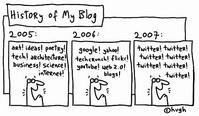 I suppose that one of the reasons that I and many other people don't blog as much as they used to is that we're microblogging. "Microbloging" is one of the words for what you do on Twitter or Facebook. Instead of attempting to write articles, one does little one-liners to answer the question "What are you doing?", preferably a number of times during the day. I suppose that one of the reasons that I and many other people don't blog as much as they used to is that we're microblogging. "Microbloging" is one of the words for what you do on Twitter or Facebook. Instead of attempting to write articles, one does little one-liners to answer the question "What are you doing?", preferably a number of times during the day.
You can squeeze quite a bit into 140 characters, and it inspires people to be more clear and succinct. It might inspire people to be mindful of what they actually are doing, what they feel, what they actually have to say. Then again, it might make others go on an on about nothing much. A lot of my friends in social networks are some kind of tech gurus. People who'd speak at tech conferences. Many of them are talking a lot about twitter. How it somehow is an answer to everything, replacing blogs, bookmarks, search engines, forums, etc. And I think it is cool too. It is just not quite there yet. You can't have much of a conversation on twitter. And you can't really talk about what you're really doing. Nobody's working on twitter, for one thing. Oh, people are flying around, meeting interesting people, speaking at conferences, etc. Which for some people is some kind of work. But what's missing is all the detail, what's actually going on, how you actually do it, who pays for it, etc. Both blogging and microblogging are mainly for show. Microblogging feels a bit more real, more real time, more honest. But it still has to adhere to a certain agreed format, which doesn't leave room for more than the highlights. Most of what we'd call "work" involves a certain intensity and volume and a certain persistence. You stay with something until you've gotten some kind of result. That takes whatever it takes, maybe trial and error, maybe a certain amount of time, certainly a certain series of actions. The log of what you actually did would be quite voluminous. You could have a meeting in an instant messenger or twitter format. Or you could have a meeting in the comments of a blog. I mean a meeting where there's something you need to decide or plan or solve. That could easily be a hundred messages exchanged between the people who're involved. But nobody would have the patience for listening to that on twitter, unless they were part of the same project. Too much, too boring, too revealing. Which is why nobody shares much of what they really do, other than markers. "I arrived in New York", "I'm going to the Google board meeting", "There's a fly in my coffee". We get a sense of what kind of stuff this person is up to, and a sense of who they are. But no sense of what they actually do that's working. OK, I have a bit of the same problem with people in the real world: that it usually is a well guarded secret what they really do. But that's a different discussion. My point here was more about the search for a format for online interaction that both allows a peripheral awareness of what many people are up to, and that also allows more intensive activity to happen, without having to "go somewhere else" and do it. Maybe Google Wave? [ Information | 2009-06-11 18:53 | 5 comments | PermaLink ] More > |
| Saturday, February 23, 2008 |
| Web 1, 2, 3 and 4 |
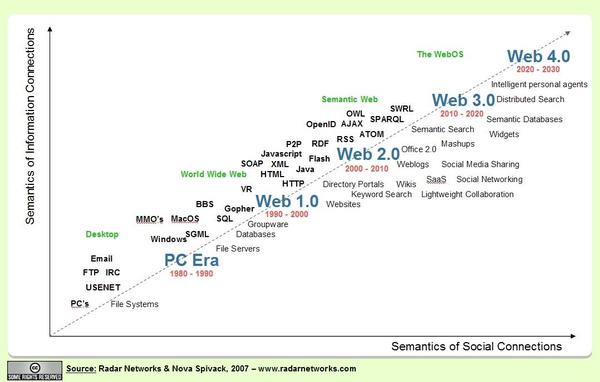 Nova Spivack has a nice video presentation, of the Semantic Web, and a suggestion of what would be called Web3.0 and Web4.0. For dummies. Well, for a group of French business school students, at least, but it means he explains it in simple terms. He labels Web1.0 as the "Worldwide Web", Web2.0 as the "Social Web", Web3.0 as the "Semantic Web", and Web4.0 as the "Intelligent Web". The graphic there is older than what he uses in the video, so the labels are a little different. Of course, since it hasn't happened yet, nobody can be sure what it will be or what it will be called, but this makes very good sense. Particularly, it makes sense to plot it on such a graph, where the Y axis is connections between information, and the X axis is connections between people. Web 2.0 connects people and information pretty well, but it is based on relatively crude methods, such as matching people and information up based on keyword searches. The Semantic Web implies that information is encoded with metadata, so that for example a search for the animal "jaguar" is different from a search for "jaguar", the car brand, or "jaguar", a version of Mac OSX. I.e. the data is more structured, so you would be able to get more precise and appropriate answers to queries, and you can ask for more complicated stuff. In The Intelligent Web, it would all become an integrated whole, like an operating system. It wouldn't matter where something is stored, by what program, on what server. It would be like "Computer, give me ...", and it will find it. And that this web would be more proactive in getting you stuff without you having to first ask for it. Of course that's all rather fuzzy, and he places that in 2020-2030. And, of course, nobody has any real good answer to who's going to encode everything with metadata for Web3.0, and nobody has invented anything that looks much like the Artificial Intelligence needed for Web4.0, so it is all up in the air. But it is a good and simple road map. [ Information | 2008-02-23 17:19 | 4 comments | PermaLink ] More > |
| Friday, February 22, 2008 |
| Illusion |
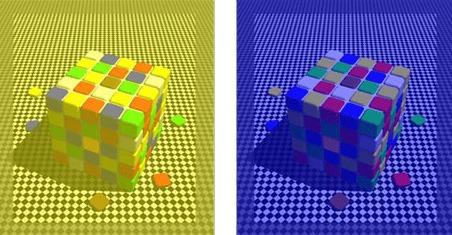 If I told you that the blue tiles on the top of the cube to the left is the same color as the yellow tiles on top of the cube to the right, how much would you be willing to bet that I was wrong? If you have an eyedropper plugin in your browser, or as a tool on your computer, you can check it out. They're exactly the same color. You brain is fooling you. Here's another one: 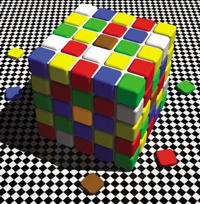
The brown tile in the center of the top face, and the yellow tile in center of the side facing front left, what do you say? They're exactly the same color. (Via BoingBoing [ Information | 2008-02-22 11:07 | 5 comments | PermaLink ] More > |
| Wednesday, January 9, 2008 |
| A Communication Model |
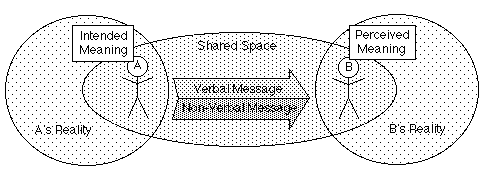 Somebody asked for permission to use my old graphic here in a training course for field epidemiologists in Kazakhstan. Which is kind of funny. And I don't remember if I ever posted it here, so why not. Below is the article that goes with it. Although I thought it was kind of well hidden on the net, I do get these kinds of requests from time to time. ... And now that I notice it, this is actually the #1 "I feel lucky" entry for "Communication Model" in Google, which I can't complain about. There is always a sender and a receiver in communication. At least there is an intended receiver. In the diagram above A is the sender, B is the receiver. A and B have different personal realities. They each have their own world formed by their experiences, their perceptions, their ideas, etc. They will perceive, experience, and interpret things differently. The same event will always be perceived a little different by each of two people. For the consideration to communicate to appear at all there must be some kind of shared space. The participants must have some kind of concept of each other's location and of a possible channel of communication existing between them. They must agree sufficiently on these to agree that communication is taking place. The sender will have some kind of meaning she wishes to convey to the receiver. It might not be conscious knowledge, it might be a sub-conscious wish for communication. What is desired to be communicated would be some kind of idea, perception, feeling, or datum. It will be a part of her reality that she wishes to send to somebody else. Something will be transmitted across a distance in the shared space. We can regard it as an object, a particle, or as a wave, or flow. It might be sound vibrations, rays of light, words, pieces of paper, cannon balls, body language, telepathy, or whatever. Between humans there will be several layers of the message being sent. There will often be a verbal portion, something that is being expressed in language, spoken or written. And there is also a non-verbal portion, covering everything else, most notably body language. Sometimes the verbal and non-verbal messages don't agree with each other, they are incongruent. If they do agree we say that they are congruent. Based on what the receiver perceives, and based on her interpretation of the verbal and non-verbal input, she will form a concept in her reality of what the meaning of the message is. It will mean something to her. It might or might not be what was intended by the sender. In successful communication the perceived message will approximate the intended message to the sender's satisfaction. However, the sender will only know that if she receives a message back that is congruent with what she had in mind. One can never take for granted that the receiver has the same reality as the sender. One can never take for granted that the receiver will interpret the message the same way as the sender intended it. Communication is not an absolute finite thing. Particularly, communication with language is always vague and misleading to some extent. If A says a word, like for example "trust", she has a certain meaning attached to it in her reality. She has had certain experiences with the subject matter, she has made certain conclusions about it, and she has certain perceptual filters concerning it. The meaning of the word is all the stuff it is associated with in her reality. However, because words also have nice, finite dictionary definitions it might appear as if the word is something very precise. What travels across the communication channel is NOT all the associations that A made about the word, and NOT the intentions she had with using it. What crosses the distance is symbols. When B hears the word or sentence she will interpret it based on her experiences, perceptions, and opinions. She might supplement the verbal information with non-verbal information such as body language. She might also hallucinate what it is supposed to mean. In one way or another she arrives at the meaning she assigns to it. There is wide agreement, at least within a particular culture, on what common physical objects are. When you say "car" or "refrigerator" most people will have an understanding very close to yours. But if you say words for abstract qualities, like "trust", "love", "right", "wrong", and so forth, then there is wide variance on what people mean. To have effective communication one needs to take all the factors into consideration. The different realities, the space the communication takes place in, verbal as well as non-verbal messages, the intended meaning versus the perceived meaning. [ Information | 2008-01-09 22:45 | 3 comments | PermaLink ] More > |
| Sunday, December 2, 2007 |
| Give One Get One |
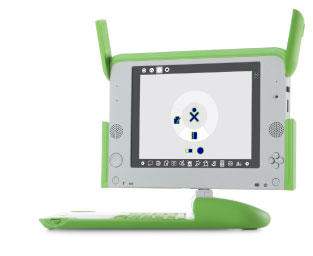 If you somehow have missed it, you can buy an OLPC laptop for yourself or a kid in your family, and you'll at the same time be giving one to a child in the developing world. All for $399. If I were in the US, I'd do just that. The offer has been extended to the end of the year. You go here: Give One Get One. If you somehow have missed it, you can buy an OLPC laptop for yourself or a kid in your family, and you'll at the same time be giving one to a child in the developing world. All for $399. If I were in the US, I'd do just that. The offer has been extended to the end of the year. You go here: Give One Get One. The mission of One Laptop per Child (OLPC) is to empower the children of developing countries to learn by providing one connected laptop to every school-age child. In order to accomplish our goal, we need people who believe in what we’re doing and want to help make education for the world’s children a priority, not a privilege. [ Information | 2007-12-02 20:41 | 5 comments | PermaLink ] More > |
| Thursday, October 25, 2007 |
| Static or dynamic web metaphors |
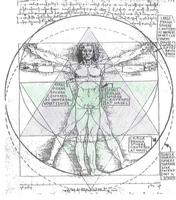 Anthony Judge: Transforming Static Websites into Mobile "Wizdomes" - enabling change through intertwining dynamic and configurative metaphors. Always interesting and challenging reading from Tony Judge. Anthony Judge: Transforming Static Websites into Mobile "Wizdomes" - enabling change through intertwining dynamic and configurative metaphors. Always interesting and challenging reading from Tony Judge.
The metaphors we employ to travel the web are extremely pervasive, but almost invisible to most. Same thing with how we use computers in general. I'm sure a lot of folks can't imagine anything different than their computer having a "desktop", even though that's a strangely antiquated metaphor to use. Here we have a mindblowing amount of computational power, and software that can deal with a hundred dimensions just as easily as two, and then we model the whole thing around a copy of our desk, with folders and pieces of paper and a trashcan. With many of the same limitations our desk has, which is exactly what we need to go beyond. Seems silly, but habit is strong, and often we can't see anything other than what we're presented with, and what we're used to seeing. Here's from Tony's article, about "sites": There is the interesting possibility that "site" may come to be understood as a static outmoded metaphor for the manner in which people and collectives find it appropriate to engage with the universe of knowledge. Site implies a particular location, especially the location with which the web user has some involvement and which may be deliberately constructed as an articulation of individual or collective identity. From there one can travel to other locations which others have configured to represent their's.Hm, yeah. So, a *site* is kind of like a shrine one leaves behind, while one is out doing other things. It might have a bookcase with your favorite books, a collection of your writings, a picture of you, some of the things you like. Why not the teddybear from your childhood, a jar of your favorite peanutbutter, a wardrobe with your old clothes, and a TV playing your favorite shows? There are organizations of various kinds that leave an office in their building standing ready for their long dead founder. It has a nice comfortable chair he would have liked, a box of his favorite cigars, or whatever it was he liked. And somebody will come by and clean it once per week, and make sure things look just right. Is that really the kind of vibe we want in a website? When we add more dimensions and more tools, people will often just create more of the same. I'm thinking of virtual worlds. One buys a plot of land in Second Life, builds a house, looking just like a house in the regular world, with pictures on the wall, books in the book case, music on the stereo, etc. OK, one has the opportunity of making something one couldn't do in real life, because it is would be either impossible or too expensive. One can have an avatar much more beautiful than one really is, and one can live in a mansion, and own a flying Ferrari. But it is still sort of the same thing. A somewhat static place that will represent what one wants to be thought to be, even while one isn't there most of the time. Tony offers a bunch of possible alternative paradigms and related models and ideas. A whole bunch. One of the alternatives ways of looking at it: Rather than constructing a site, and visiting other sites elsewhere in cyberspace, suppose the focus shifted to the "vehicle" in which one travelled. Such a shift in paradigm is evident in the case of people who choose to invest in a mobile home to travel their continent, possibly with little immediate intention to return to a particular physical location. The focus is then on the design of the mobile home (a caravan) and its capacity to move. The "centre of gravity" of identity is then with the vehicle and its enabling capacity rather than with some particular physical space. A similar shift in identity is evident in the desire of people to possess a vehicle that better reflects their sense of identity than the place they are obliged to dwell for socio-economic reasons.OK, so, yes, an avatar would be an example of that. You work on designing the part that's moving around, rather than the part that stays behind. At the same time we're still stuck to some degree with the same metaphors that limits a mobile home to be as much as possible like one's static home, however much one can manage to stuff it into a box on wheels. One can get very fancy in designing an avatar for a virtual world, but it is still within the realm of some kind of body, without necessarily getting any new perceptions or access to larger amounts of data or anything. And I'll argue that more useful interfaces would be more in the direction of extrasensory perceptions and out of body experiences. I mean, instead of duplicating or merely enhancing what we do every day in the meat world, we might make a much bigger jump and imagine what we actually might be able to do if unburdened by the limitations of having to drag stuff through 3 dimensions, which takes time and effort. In principle, the internet-connected information world would allow you to be anywhere instantly and have access to any amount of information in any way you'd want. Do you really need to "travel" to a "site" and read "documents" in order to get to it? Even if it isn't just that, every site has its own metaphors and paradigms and rules and procedures. You need to sign up, you need to figure out the menus, the different "rooms" of the house that somebody presents you with. That's of course not all that is going on on the web. A lot of protocols and mechanisms are emerging that potentially allow us to access things in our own way, without having to learn the map of somebody's house. Feeds, APIs, etc. Potentially we have some of the building blocks for creating a drastically different experience. Back to Tony's article. He proposes some sort of structure that you can take with you, which can replace the metaphor of a site. He calls it the "Wizdome". "Wiz" can be for wisdom, as opposed to knowledge. And "dome" because it maybe could be thought of as being spherical, or maybe geodesic. Combining these two suggested shifts in metaphor -- to the spherical and to the dynamic -- the question for the individual is whether what is required is to design such a "wizdome" from the elements of knowledge accumulated on any current website. Can such knowledge elements be configured spherically in a fruitful manner for that individual? Can a site be "endomed" or "domified"? What kinds of insights and expertise are required to bring about any such "enwrapping" of knowledge -- beyond what the problematic aspects of cocooning? What is to be "encompassed" and how is this to be distinguished from any "encyclopedic" ambition...?Hm, maybe sort of like a merkeba, an interdimensional vehicle, often considered to be constructed of interlocking tetrahedra. Some kind of vehicle to travel in on the interwebs might constitute progress. There's me, and there's a whole lot of information out there, which I might want to interact with. I'd like to get beyond that each separate store house of information will build a house for me to visit to come look at it. And we're already halfway there. I read news in a feed aggregator, I choose my own e-mail programs and instant messenger programs. Although each of those have their own limitations, standing between me and what I'd like to do. I can sort of have these different tools at hand even while I travel around. I can chat in an IM program while looking at different websites, obviously. I can stay connected with a feed of messages from my friends on different computers, or on my mobile phone. But to get further in terms of a different experience in dealling with the information world, is it still something like that the Semantic Web that is needed? That all available information is thoroughly labeled, measured, categorized, so that I could use some completely universal tools to access it in any way I want, rather than having to put up with a million different interfaces. And, since nobody is going to do it for us, will it emerge as a folksonomy? Either way, some old structures will have to die out before all this inter-connectivity really can live up to its potential. The internet is still a little too much like a thousand channels with nothing on. Oh, there's a lot on, an there are interesting channels, but it is hard to find what you really want, and do with it what you'd really want to do. Because the metaphors are getting in the way. [ Information | 2007-10-25 21:47 | 10 comments | PermaLink ] More > |
| Tuesday, September 18, 2007 |
| Rethinking blogs |
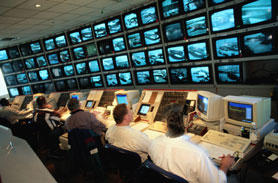 Now, what was I saying? I've forgotten, I'll have to read my own blog. Now, what was I saying? I've forgotten, I'll have to read my own blog.
The trouble with blogs, and microblogs too, for that matter, is that one tends to be locked into one track. It is still a bit too much like publishing. You know, if you were publishing a monthly magazine, you'd be expected to produce a certain number of articles, good pictures, a certain type of content, a certain number of pages, and it needs to be finished at the right time. In blogs you can in principle say whatever you want on any topic. And in a microblog (twitter, jaiku, facebook), you certainly can, and it doesn't even have to be important or well thought out. But, still, most people will stay within a particular subset of their life. A lot of my blog friends seem to be living and breathing social software. Cool new technology fits in well with that too. And it is acceptable to talk about that you're going out to lunch, or that you're waiting for a plane to go somewhere. And a few other odds and ends to show that you're human. But, still, most people stay within a certain format and frequency, and mostly expect the same from others, and would frown upon somebody who uses these media differently. Like, if one person sends out 200 twitter messages in a day about the fish in his fish tank, a lot of his friends would unsubscribe. But what if that really was what was on his mind that day, and what he felt needed to be said? One channel is never enough. We all have many channels in our lives. And we're probably only interested in some of other people's channels, but never all of them. And that's cumbersome to manage with the current software, unless you focus on very few channels that don't change much. When I bother to write in my own blog here, I write about a variety of changing subjects. I don't feel there's much I couldn't write about, but I feel somewhat restricted in how much I can write about any one thing that I'd consider off-topic of my idea of the general theme. Right now I'm very busy in a little start-up company I'm a partner in. I could write a post about that. But, really, that has been a lot of my day for a couple of months. So, what if I wrote a couple of posts a day about what I was doing, and what problems I run into? I don't necessarily feel like doing that, but that's part of where my attention would be. So, what if I wrote about Ruby on Rails development for a couple of months? Other people do nothing but that, and that's perfecly great. But it probably isn't what people come to my blog for, and I'd probably lose people who weren't into programming. Recently my hobby in my limited spare time has been genealogy, tracking down current or long-dead family members. I could write a lot about that, and that might be interesting to others with the same interest. But what if I wrote a couple of posts a day about it here in my regular blog? What if I chronicled my progress in a few dozen twitter/jaiku messages per day? I dare say it would probably be annoying to most people who glance at what I write. I could find a whole bunch of new genealogy friends, but that would be a different crowd, and they might not what to hear me philosophize about the nature of space time, or about social software, or about my programming projects. They'd want to hear it a little bit, to know me better, but they probably wouldn't want the whole channel. And there we're even still talking about Subjects, Topics, that one discusses somewhat from a distance. What if I were blogging about the details of my family life, about my personal psychological issues, about my health, or, gee, my sex life. There are lots of people doing all of those things, but generally not at the same time. There are very few combined Ruby programming and sex blogs. And if there are any, it is because somebody came up with a new gimmick, an unusual angle. So, to get to the point, I'm missing tools for being able to chronicle my own activities and interests, and selectively share some of them with others, and at the same time being able to follow the activities and interests of others, without getting too much or too little of what I'd want to know. It is not an easy problem to solve. Yes, I could easily use categories and tags to organize the things I write, and I can decide what is published and what is not. But if I then present a list of feeds in my sidebar here, which one can pick and choose from, I'd say that a fair number of people who decide to pay attention to me will just subscribe to all of them. And if they find that a lot of what I'm talking about, in some of those channels, doesn't interest them at all, I'd guess the tendency would be to unsubscribe from all of them. And if somebody had picked just some tags from my selection, they wouldn't easily discover when I go in different directions and write about totally different topics. They'd probably just wonder why I went silent. The twitter microblogging idea is in part that if the messages are really small, we're perfectly fine with getting the whole feed from a whole bunch of people, even if 90% of what they do has no interest to us. Whether they're at the mall shopping for clothes, waiting for the bus, reporting on a tech conference, or saying something funny, it all just scrolls by, and we can pick out anything that might have interest, and ignore the rest. But that only works as long as these people stay within a socially accepted norm of how much they should post about each thing. 2 or 3 messages about you trying to sell your motorcycle would be fine, but if you posted 50, a lot of people would complain and unsubscribe. The problem is that everything is in one channel and presented as having the same level of importance. I'd maybe be interested in knowing that a lot of your attention is going into a certain subject and that you've written a lot about it, but I might not want to see it all in the same precious one channel. It is a matter of peripheral and focal attention. I'd like to know about a lot of things, like what a lot of people are into, but some of it I'd want to know about only peripherally. I.e. I'd know it is there, but not have to pay attention to the details. And other things I'd want to focus on. So, I want tools that would allow me to do that more fluidly, in a more flexible way than simply subscribing to your one channel, and unsubscribing from it when it bores me too much. Then there's the growing number of people who walk around with live streaming cameras on their heads all day. See justin.tv. There you have to tune into a particular channel, and you see live whatever those people happen to be doing at the time. Which is a type of reality TV, and quite compelling in its own right. But you only see one channel at a time, so it doesn't quite plug into a similar thing like blog aggregators or twitter channels. But it is related to blogging. I wouldn't mind being able to tune into the live feed of a bunch of friends, and having one screen where I can see all their feeds at the same time, and then focus on any one I want. But other than that, there's no good way of aggregating that at the moment, because it is just too much information. Anyway, I think what makes the most sense is blogs transforming more into personal information portals, or personal presence portals, and that somebody needs to invent better ways of aggregating such things. Some companies are trying things in that direction, by aggregating your friends' blogs, tweets, delicio.us bookmarks, flickr pictures, etc, in one place. But it is messy, and it does the same mistake of bundling even more things into one channel. If I should imagine my own blog differently, it would present a number of different kinds of feeds at the same time, leaving out the illusion that there's just one. Yes, I know I can have different things in my sidebar, like my recent Jaiku messages, my location in Plazes, my recent Flickr pictures, but there's probably just one of each, and there's one stream of my most recent messages. Which is kind of what defines a blog: a website format where one posts articles and the most recent one is at the top. And however neat that is, that is what I find limiting. Maybe all it takes is a different layout. Maybe like a newspaper front page where there are different columns. You usually wouldn't feel that it is required of you to read the whole thing through. You'll read the colums that you're interested in, and you're peripherically aware of the others. Personal portals like Netvibes do that kind of thing, but really as a vehicle for me publishing stuff like I can in a blog. What I need is a blog where I or the visitors can rearrange a bunch of feeds to their liking. And a way of aggregating a whole bunch of people's personal portal information. I have trouble imagining the perfect way of doing it. But if I didn't have too many other things to do, I'd probably get busy trying to program it. [ Information | 2007-09-18 22:54 | 9 comments | PermaLink ] More > |
| Wednesday, July 4, 2007 |
| Scrutiny of Information |
Via Frank Patrick:"If a man is offered a fact which goes against his instincts, he will scrutinize it closely, and unless the evidence is overwhelming, he will refuse to believe it. If, on the other hand, he is offered something which affords a reason for acting in accordance to his instincts, he will accept it even on the slightest evidence. The origin of myths is explained in this way."Yeah. But what is instinct? If you break it down into perceptions, most people ultimately make big decisions not based on logic, but based on that it feels right. Very often a physical feeling around your stomach area. The "gut feeling", you know. There are always more perceptions involved. Maybe it *looks* a certain way to you, in your mind's eye, and it *sounds* about right in your mind's ear. And, yes, some kind of feeling that seals the deal, that "this is right!" Most people will be likely to deny this, and will insist that they make their decisions based on a careful study and analysis of available facts, which they logically add up into a decision. Oh, nothing wrong with careful analysis and logical reasoning, but even if you're very good at that, like if you're a scientist, you end up deciding whether it is right or not, and that decision is based on some kind of feeling you have, however much you deny it. Some people merely make up the reasoning after they've had that feeling, in order to defend the "logic" of it. Others will try to go through some kind of routine before, to show that they seriously worked on the decision process. But it still ends up being some kind of feeling of it being "right" or "wrong". However, there are several kinds of what we could call instincts. In my experience, everybody has a built in sensor for their personal right or wrong, which almost instantly will give the answer, based on some kind of subconscious processing of all available facts, or based on something more esoteric, and this mechanism will tend towards never being wrong. That's what we maybe could call intuition. But at the same time, most people are easy to fool, in a long list of different ways. You can be led to believe that something is something else than what it is. You can be led to see something as normal, even though it isn't. Stage magic, hypnosis, advertising, politics - there are many places you'll find such tricks used. People will manipulate you into choosing a certain reality, because it looks, feels or sounds right, even though it isn't. I suppose that's playing into instincts too. But it isn't intuition. Recognizing the difference between those different kinds of instincts can be hard. A lot of people probably know no such difference. If it feels right, it is right, whether it is the call of your destiny, or a commercial on TV. Anyway, the question is how we maybe might train ourselves into being fooled less, by information or by perceptions. How can evidence and instinct get more into sync? I think that starts with what Alfred Korzybski called "Consciousness of Abstraction". That you're aware of the existence of the various layers and filters through which you deal with "reality", and that you have an idea of their pros and cons, strenghts and weaknesses. If you try to deny that any of those layers exist, you'll make stupid mistakes. The more conscious you are of your processes of abstracting reality into ideas, and of concretizing ideas into reality, the less likely you are to be fooled. [ Information | 2007-07-04 23:59 | 2 comments | PermaLink ] More > |
| Tuesday, July 3, 2007 |
| Strangeness |
“The higher the degree of strangeness in an event, the greater its information yield is likely to be.”Yep, strange is good. It often means you're about to learn something. You don't learn much from the same old, same old. You need to be woken up a little bit, or a lot, to truly learn something new. Mystery, puzzlement, wonder, awe - they're great drivers. [ Information | 2007-07-03 01:24 | 1 comment | PermaLink ] More > |
| Sunday, June 17, 2007 |
 I've seen this movie before but this sequel is different & better because it's a blockbuster and everybody's doing itRoland Tanglao, paraphrasing Tim Bray. We're talking about Facebook. I didn't pay attention to Facebook before just recently. I'm a member of too many online social networks where I have a list of "friends", and nothing else is going on. And at first glance Facebook sounded like just another one, and one I'd be even less interested in than the others. Its positioning seemed to be about finding people you went to college with and that kind of thing, which sounded boring. I had indeed signed up quite a while ago, and I was getting friend confirmation requests. But the problem is that the options they give you all seemed irrelevant. Normally I've met people online, maybe through blogs, maybe we were in the same network or group or something, or maybe we met at a conference. But none of those are among the choices, so I had to settle for "Met Randomly", even though it wasn't very random. So that just confirmed that it wasn't for me, and I never logged in. Until it became apparent that a lot of people I know think it is a great thing, and I actually logged in and looked around. And, indeed, there are some things they do that lift it to a whole other level, and it isn't very much at all like Ryze, LinkedIn, Orkut, Xing or Viadeo. The first thing is that you get a feed of what changes about any of your friends. The second is that there's a whole lot of things to do, so there's a lot to see in that feed. And, thirdly, they have what they call applications. It means they've made an API that allows third parties to add modules to their hearts content, to add new functionality, which is nicely integrated with the rest of the site. Those extra modules make me do some things I otherwise wouldn't bother doing, like rating books I've read recently, because the fact that it is shared with my friends list makes it somewhat more meaningful. None of it is particularly important stuff, but it hooks into the same principles that makes twitter or jaiku interesting. It gives me a continuous ambient awareness of what's going on within one's sphere of friends. There's a swarm kind of thing going on, where I'll catch if a bunch of others suddenly get interesting in a particular subject or a particular application or a particular group. And it does that for me with fairly minimal investment of time, as all I do is to update a few profile type of settings here and there, and I watch one stream of small updates from others I know. So, this does point at something that's new and interesting, a new type of social interaction, and a trend for the future. But, like the other social networking sites, Facebook is an island. You don't really plug into it unless you're a member. And what if there are several places like that, and I'll had to choose. It is only going to be more permanently useful if there are open standards, and it doesn't matter which particular system I plug into. I'm interested in sharing information with my friends, but I could care less about keeping track of a list of separate websites one can network at. They would have to become more invisible. [ Information | 2007-06-17 20:09 | 4 comments | PermaLink ] More > |
| Wednesday, June 6, 2007 |
| See no evil |
Cory Doctorow in Guardian about filtering and censorship versus freedom of expression on the net:People say bad things online. They write vile lies about blameless worthies. They pen disgusting racist jeremiads, post gut-churning photos of sex acts committed against children, and more sexist and homophobic tripe than you could read - or stomach - in a lifetime. They post fraudulent offers, alarmist conspiracy theories, and dangerous web pages containing malicious, computer-hijacking code.There's unfortunately a lot of milage one can get out of loudly pretending to be solving a problem, even know one knows full well one isn't, and one creates many more that are worse. "But we should at least try ..." is one of the wackiest arguments used to defend the most horrific and ineffective campaigns. To "protect the children" is a common thing to fill in there. Let's punish a lot of innocent people ... to try to protect the children. [ Information | 2007-06-06 21:18 | 1 comment | PermaLink ] More > |
| Monday, June 4, 2007 |
| Rebooting the Web 2.0 age |
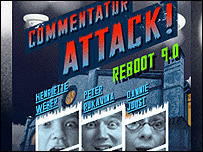
Nice writeup at BBC about Reboot by Jem Stone, who was one of the participants: The future of the web is being debated at Reboot 9.0, a leading European grassroots technology and design conference in Copenhagen. [ Information / reboot9 | 2007-06-04 15:50 | 0 comments | PermaLink ] |
| Sunday, June 3, 2007 |
| Flow |
| How does one best capture what one can take away from a lecture? One can just somehow process it and internally organize it as one hears it, I suppose. Or one can count on being able to watch the video later. Or one can take notes. But how? I unfortunately missed Stowe Boyd's talk on Flow, a new consciousness for a web of traffic, in order to be in a conversation about owning one's learning path. But Lars Plougmann made his notes in the form of a nice mind map, which you can see below. And when Stowe puts up his slides, I guess I can piece the point together. Mind maps is a good way of keeping notes.
[...Later] Video of Stowe's presentation here. [ Information / reboot9 | 2007-06-03 15:35 | 2 comments | PermaLink ] More > |
| Microblogging |
 I don't jump on all technofads right away. Like, I couldn't really see the point of Twitter. Why would I want to get an SMS about whatever somebody I know is having for lunch? I wouldn't have to, of course, as one could configure it differently. But the horror of that thought, to be woken up in the middle of the night to hear that somebody on the other side of the world is standing in line at McDonalds, kept me from even looking at it. And of course I didn't quite get it. It is indeed an excellent idea. I don't jump on all technofads right away. Like, I couldn't really see the point of Twitter. Why would I want to get an SMS about whatever somebody I know is having for lunch? I wouldn't have to, of course, as one could configure it differently. But the horror of that thought, to be woken up in the middle of the night to hear that somebody on the other side of the world is standing in line at McDonalds, kept me from even looking at it. And of course I didn't quite get it. It is indeed an excellent idea.
The cool idea is microblogging. Instead of having to feel obliged to write whole articles on important subjects with well reasoned arguments, one can post one-line snapshots. Where one is, what one is doing, what one is thinking, etc. Which one can do often and easily, from the web, from IM programs, by SMS. And people who know you can keep on eye on your activities and thoughts, whenever and however they feel like it. Personally, I do sometimes get blogging anxiety, in the form of thinking that if I post something, it has to be of a certain volume and quality, particularly if I haven't written anything for a little while. In the meantime I've been doing lots of things, but maybe nothing that overcame my threshold of being bloggable. But for a microblog, the threshold is much lower. That I'm sleeping or eating breakfast is perfectly newsworthy, in part because the one-liner about it isn't going to bother anybody, and on the contrary it puts me on the map as a blip. And maybe I do get a brilliant idea after breakfast and post that too. Twitter is the most well-known service, but I like Jaiku better. Quite a few more useful features. And it seems to be more popular with the European crowd, and we've sort of seen it be born over the last several Reboot conferences. I'm ffunch on Jaiku. And also on twitter, although I'm not likely to use that very much. It only gets fun when you have a list of contacts of course. But then it is ambient intimacy, alright. You can easily maintain a peripheral awareness of what a whole bunch of your friends are up to, without spending too much energy on it. [ Information | 2007-06-03 14:34 | 0 comments | PermaLink ] |
| Monday, April 2, 2007 |
| Being consistent |
Scott Adams on Dilbert Blog:I’m reading a great book called “Influence: Science and Practice” by Robert B. Cialdini. It’s full of research and anecdotes about how to influence people. It’s a real eye-opener.It's an odd thing. We bend over backwards to appear to be normal and consistent and logical, and in doing so, we tend to become easy to manipulate, and we'll do crazy things without even blinking. [ Information | 2007-04-02 21:10 | 15 comments | PermaLink ] More > |
| Friday, March 23, 2007 |
| To simplify things |
You need only two tools: WD-40 and duct tape.(Via Vila) [ Information | 2007-03-23 18:38 | 4 comments | PermaLink ] More > |
| Saturday, March 17, 2007 |
| The Digital Bedouins and the Backpack Office |
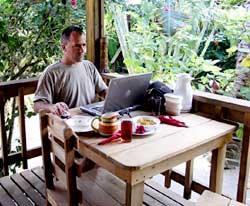 Slashdot: Slashdot:"The laptop and wireless revolutions have led to the rise of a new class of digital 'Bedouins' — tech workers who ply their crafts from Starbucks and other locations with WiFi access. Another article describes some strategies and tools for embracing the Bedouin way of life, and even having fun: 'If you have the right kind of job, you can take vacations while you're on the clock. In other words, you can travel for fun and adventure and keep on working. You can travel a lot more without needing more official vacation time. I've done it. In August I took a month long vacation to Central America, backpacking from one Mayan ruin to the next, and I never officially took time off. I submitted my columns, provided reports and other input, participated in conference calls and interacted via e-mail. I used hotel Wi-Fi connections and local cybercafes to communicate and Skype to make business calls. Nobody knew I was sunburned, drinking from a coconut and listening to howler monkeys as I replied to their e-mails.'"I like the concept very much, but are we really there yet? I feel very disconnected if I'm not by my broadband connection at home. Even if I stayed within my very civilized high-tech French metropolis, I'd have lots of trouble staying connected. Very few open WiFi connections. Lots of cybercafés, but I'd have to use their crappy Windows computers. My 3G phone should in principle keep me connected, but I haven't figured out how to use it as a modem yet, and the data charges are insanely expensive. I started trying to work as a digital nomad almost 20 years ago. I'd go travelling for weeks without officially being on vacation, but bringing a 20 pound laptop, and a bag full of road warrior gadgets. But I always had trouble, and it never turned out like I planned. Little things like it being illegal to buy a phone plug in Germany at the time. Or incompatible digital phone systems in hotels. OK, now with wifi and ubiquitous broadband, it should be easier. Except for if all the wifi connections are locked down, or they're $20 per hour. Of if you're visiting somebody with broadband, but they insist you don't touch their USB DSL modem, even though you brought a wifi DSL router. But I guess it is time for taking a fresh look at the best-of-breed tools for digital nomads. [ Information | 2007-03-17 16:47 | 7 comments | PermaLink ] More > |
| Thursday, March 15, 2007 |
| You live longer if you have a sense of humor |
YahooNews: Laugh and the world laughs with you. Even better, you might live longer, a Norwegian researcher reports.And, in case you didn't live longer, you'd have had a better time of course. [ Information | 2007-03-15 14:46 | 4 comments | PermaLink ] More > |
Page: 1 2 3 4 5 6 7 8 9 Older stories >>